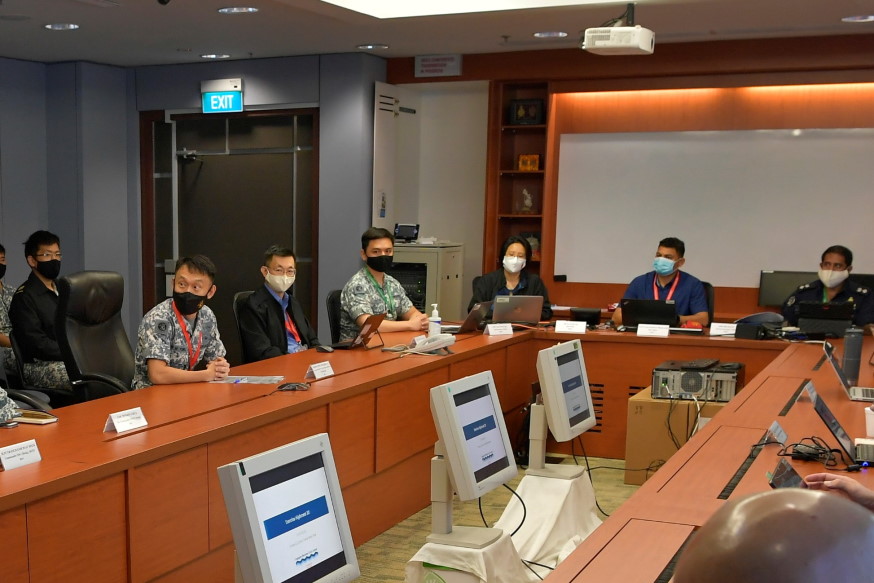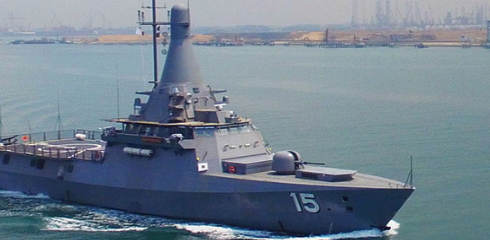“ As an island nation, our porous borders make us vulnerable to attacks from the sea. Therefore, we must ensure our national maritime security system is robust and ready at all times to deal with any threats quickly and decisively. ”
- RADM Yong Wei Hsiung, Commander, Maritime Security Task Force (MSTF)/Maritime Security Command
Against the backdrop of the on-going COVID-19 situation, access to the sea is more vital than ever. The RSN’s MSTF conducted two high-key maritime security exercises – Exercise Highcrest and Exercise Apex – from 26 Oct to 4 Nov 2020. The exercises focused on bringing together national maritime agencies and the SAF to prevent terrorist attacks on Singapore’s key coastal installations.
"Singapore is a major global maritime transhipment hub, with one of the world's busiest container and bunkering ports. On average, we see about 1,000 vessels transiting through Singapore waters daily. The porous nature of the maritime environment, coupled with the high volume of shipping traffic in our waters, makes Singapore an attractive and vulnerable target," SLTC Gary Ow, Director of Singapore Maritime Crisis Centre's (SMCC's) National Maritime Operations Group shared.
"During the exercise this year, SMCC led maritime agencies to identify and address the vulnerabilities in the complex maritime operating environment, and explore solutions to mitigate them systematically. As part of the whole-of-government (WoG) integrated operations planning, it is important that government agencies and the maritime industry can work together to achieve a secure maritime environment."
Early warning is always the best defence. At the SMCC, national maritime agencies come together to sense-make, identify anomalies, and uncover potential threats. This includes information provided by the Maritime and Port Authority of Singapore (MPA). "MPA shares information on vessels' arrival and other operational data in the Port of Singapore. This enables better sense-making at the whole of government-level to make the Port of Singapore safer and more secure for all users," highlighted Mr Peter Koh, Senior Manager (Security) from MPA.
Based on the information gathered, anomalies are flagged. When a threat is identified, the SMCC plans and coordinates the operational responses with national agencies like the Immigration & Checkpoint Authority, MPA, MSTF, Singapore Customs, Singapore Police Force and the Singapore Civil Defence Force to neutralise the threats, and coordinate consequence management, such as a maritime lockdown to divert and temporarily stop maritime traffic.
Given Singapore's lack of strategic depth, quick and decisive response is necessary. "As our territorial waters are our first line of defence in safeguarding the safety and security of Singapore, PCG will continue to partner our maritime counterparts and validate our joint protocols in dealing with maritime crisis, through table-top and ground deployment exercises," said Station Inspector Ma Weiliang, Assistant Operations Officer (Planning and Readiness) from the Police Coast Guard (PCG), one of the participants in Exercise Highcrest.
Over at the MSTF Operations Centre, MAJ Ivan Kwah, Watch Commander from MSTF's Sea Security Group is in the thick of the action as the MSTF directs personnel and assets from across the SAF to interdict and neutralise the oncoming threat during Exercise Apex. Exercise Apex saw the deployment of MSTF, Special Ops Task Force (SOTF), Chemical, Biological, Radiological and Explosive Defence Group personnel, Independence-class Littoral mission vessel RSS Unity, multiple Super Puma helicopters and a Heron 1 Unmanned aerial vehicle in an interdiction operation at sea.
"When MSTF detected a developing threat from the commercial vessel, we raised the alert and readiness of our patrol ships at sea, and also cued our Singapore Armed Forces (SAF) and WoG partners to response. Once the threat is neutralised, MSTF coordinates consequence management activities to render the vessel safe for our WoG partners to conduct follow-on investigations."












